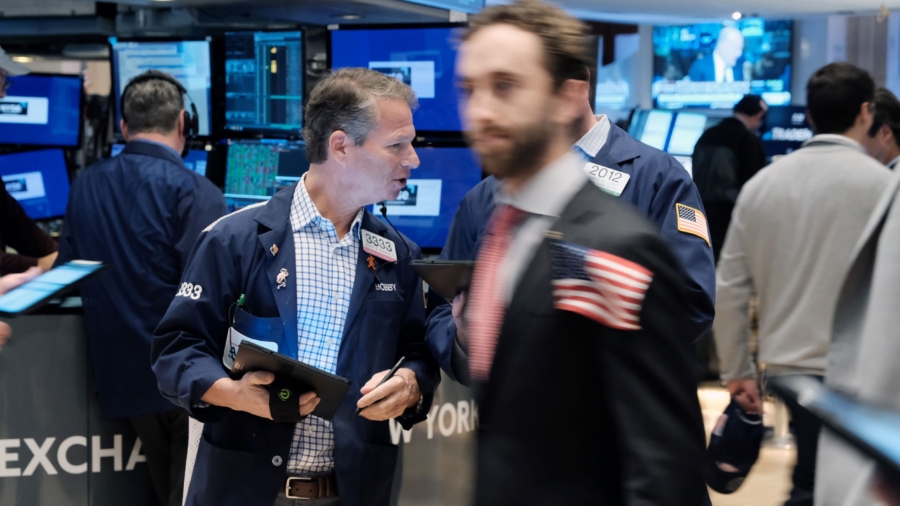Wholesale inflation rose by 8 percent in annual terms and 0.2 percent in monthly terms in October, suggesting inflationary pressures for consumers are far from dissipated, but stocks rallied on the opening bell as investors thought the price data would be worse.
Investors expected that inflation from the perspective of business input costs, as measured by the Producer Price Index (PPI), would rise 8.3 percent in the 12 months through October, and by 0.5 percent month over month.
But data released on Nov. 15 by the Bureau of Labor Statistics (BLS) came in slightly cooler, at 8 percent year over year and 0.2 percent month over month, sending Wall Street’s main indexes higher as the lower-than-expected numbers bolstered bets that the Federal Reserve would slow its pace of rate hikes.
At the opening bell, the Dow Jones Industrial Average rose 219.2 points, or 0.65 percent, to 33,755.94. The S&P 500 Index rose 49.2 points, or 1.24 percent, to 4006.41, while the Nasdaq Composite rose 278.6 points, or 2.49 percent, to 11,474.82 after the markets opened.
Producer prices tend to be a leading indicator of consumer price inflation as some portion of business input costs get passed along to consumers.
Peak Inflation?
The lower-than-expected wholesale price acceleration data prompted a number of analysts to suggest inflation is slowing.
“Oct. PPI came in way below expected. That’s the second data point in a row to suggest inflation has cooled,” Gary Black, managing partner at The Future Fund LLC, said in a post on Twitter.
The other data point Black was referring to was the recently released Consumer Price Index (CPI), which showed prices rising at 7.7 percent in the year through October, versus 8 percent consensus forecasts predicted.
Stocks soared on last week’s CPI inflation data, with the Dow closing 1,201 points higher the day the numbers were released.
Mary Daly, president of the Federal Reserve Bank of San Francisco, and Lorrie Logan, president of the Dallas Fed, both welcomed last week’s CPI inflation data, but warned that the central bank’s fight to quash inflation was far from over.
“This morning’s CPI data were a welcome relief, but there is still a long way to go,” Logan said at an economics conference on Nov. 10. “While I believe it may soon be appropriate to slow the pace of rate increases so we can better assess how financial and economic conditions are evolving, I also believe a slower pace should not be taken to represent easier policy.”
Still, some analysts saw the CPI data as a sign that inflation has peaked.
“This is not some kind of outlier,” wrote Omair Sharif of Inflation Insights. “This is the start … of lower prints.”
Tuesday’s PPI data sparked similar takes.
“Inflation is dead. Fed now needs to work to stop the coming recession,” Ross Gerber, president and CEO of investment consultancy Gerber Kawasaki, said in post on Twitter, reacting to Tuesday’s wholesale inflation data.
Slower Pace of Rate Hikes?
Growing recession fears have hammered Wall Street this year, with the benchmark S&P 500 Index down around 16 percent so far this year.
Tuesday’s better-than-expected inflation data prompted traders to adjust their bets on the Fed’s future rate hikes.
One day prior, federal funds futures contracts put the odds of a 50 basis-point rate hike at the central bank’s next policy meeting in December at 80.6 percent. On Tuesday, following the PPI data release, those odds climbed to 85.4 percent.
At the same time, the odds of a bigger 75 basis-point hike fell from 19.4 percent on Monday to 14.6 percent on Tuesday.
Fed Vice Chair Lael Brainard signaled Monday that the central bank is likely to slow its pace of rate hikes.
“It probably will be appropriate soon to move to a slower pace of increases,” Brainard said during a discussion hosted by Bloomberg News.
Seeking to quell soaring inflation, the Fed has rushed to raise rates at its fastest pace since the 1980s, sending the benchmark rate surging by 375 basis points since March, to a target range of 3.75–4.0 percent.
From The Epoch Times

